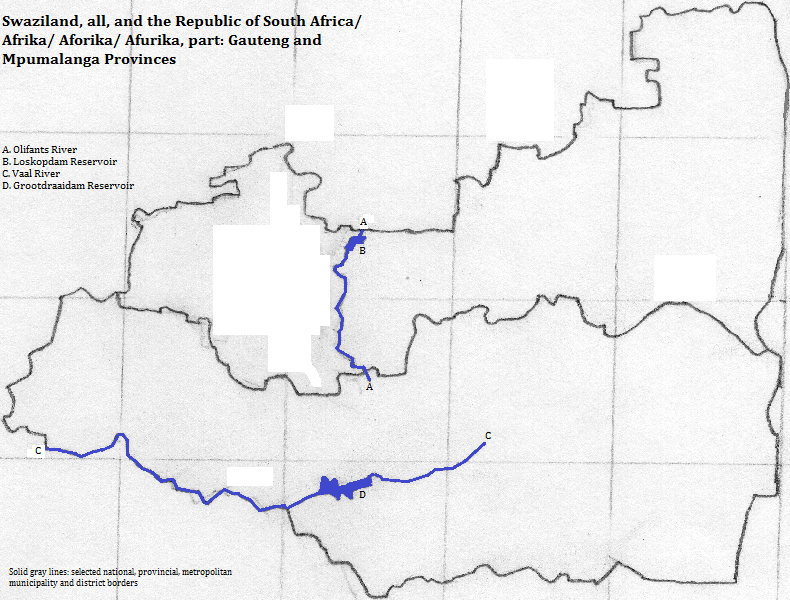
| To Duval Family Home Page | Africa |
| To Chris Home Page | Republic of South Africa/ Afrika/ Aforika/ Afurika |
| To Earth (Geography Home Page) |
Much of this area of 114 thousand square kilometers is high plateau ('veldt') and mountains. The Drakensberg cross north to south in eastern Mpumalanga, reaching above 2,300 meters. Beyond them the land falls off towards the Moçambique
Tourists visit Kruger National Park, which is partly in this area.

About 15.5 million people live here (2007). While no one language accounts for a majority, the 'S' Group of Central Narrow Bantu languages accounts for almsot eight in ten. The most important languages are:
| Language | Percent of nation | Group |
| Afrikaans | 11 | Germanic |
| English | 9 | Germanic |
| Xhosa | 6 | S |
| Zulu | 21 | S |
| Northern Sotho/ Tswana | 16 | S |
| Southern Sotho | 11 | S |
| Swati | 15 | S |
A majority follow Protestant Christianity, often with elements from the older religions, especially in the African Zionist Church and by followers of Isaiah Shambe, the Zulu "messiah". The indiginous religions include common elements: a belief in the participation of ancestral spirits in community life; the distance of a high god; and the ability of magical specialists--by birth or training--to influence the material world or to foretell events. The high god is called Modimo by the Tswana and the Sotho; Nkulunkulu by the Zulu; uThixo or uQamato by the Xhosa; and Mkhulumnqande by the Swati.
There are two cities of over a million: the national administrative capital at Pretoria, which is the core of the city of Tshwane; and the capital of Gauteng, Johannesburg.
The Khoe (or Khwe or Hottentot or Central Bushman) language speakers preceded the Bantu groups. A great many died of small pox in the 18th century, many others assimulated to Nguni speakers--a Bantu group that arrived here from the north in the 9th century. Their influence on the Nguni languages--partly caused by taboo rules on women's speach that incented inter-lingual borrowing--led to the introduction of clicks and other consonants into the Nguni languages as in today's Zulu, Xhosa and Swati. Zulu became dominant and in turn influenced Southern Sotho, a non-Nguni Bantu language, even to introducing the women's language taboos.
The Dutch moved into the area from the southwest in the 18th and 19th centuries. Their language evolved under the influence of local and non-local languages to become Afrikaans. Many ethnic Africans took up this language.
The English conquered the area in the mid-19th century but, although they lost it in the early 20th, their influence endured.
Europeans introduced Christianity, which has been furthered by missionaries and made locally distinctive through churches like the African Zionist. While that began as an offshoot of an American church, under African leadership it has become highly syncretic.
'Fossil Hominid Sites of Sterkfontein, Swartkraus, Kromdraai and Environs' is a set of sites in this area that are part of the UNESCO World Heritage Site "Fossil Hominid Sites of South Africa."
west and north
east
southeast
southwest
1. Mozambique in English.
2. Oranje in Afrikaans.
3. The boundary eventually follows the Klip.
4. Also called Isixhosa.
5. Also called Isizulu.
6. Northern Sotho is called Pedi or Sepedi in South Africa. Tswana is also called Setswana. Northern Sotho and Tswana are mutually intelligible.
7. Also called Sotho or Sesotho.
8. Also called Siswati. Swazi is a Zulu word for Swati.
9. Soweto has 1.8 million people. But, since early in this century, it has been considered part of Johannesburg.